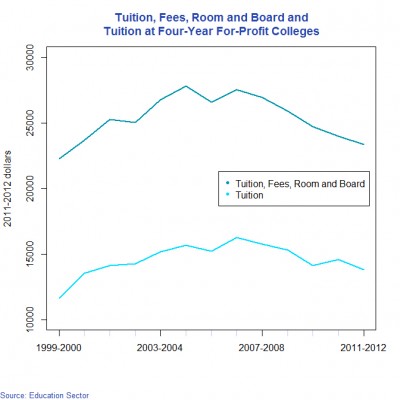The Economy Is Forcing Tuition To Fall Rapidly At Private, For-Profit Colleges
By Wired Academic on August 26, 2013
Cost of Education, Domestic, Ethics, For-Profit, Recruitment, Required, Retention Rates, Universities & Colleges
By Jon Marcus, The Hechinger Report
Private, for-profit colleges have joined the march of institutions that appear to be lowering their tuition as enrollment flattens out and families become increasingly price conscious.
The average tuition paid by students at four-year, for-profit colleges, when adjusted for inflation, fell from $16,268 in the 2006-2007 academic year to $13,819 in 2011-2012, the independent think tank Education Sector reports, citing data from the U.S. Department of Education.
Education Sector research director Andrew Gillen says one reason for this drop is that students are seeking out lower-cost schools, pushing down the average tuition being paid. The other: that the schools are cutting their prices.
“It’s an interesting question because the for-profits are obviously focused on making a profit, so if they’re cutting tuition, there’s got to be something going on,” Gillen says. “Either they’re trying to build their market share or they’re trying to undercut their competitors.”
Some public and small private universities and colleges, too, are freezing or reducing their tuition in the face of pushback from parents and policymakers.
The average amount families paid for college, per student, fell to about $21,179 in 2012, down from a high of $24,097 in 2010, the loan provider Sallie Mae has reported. That’s because more have sought out less-expensive schools, or negotiated ever-larger discounts.
Sallie Mae found that two-thirds of families eliminated one of more colleges from consideration because of cost.
Meanwhile, to the consternation of higher-education administrators, university and college enrollment has been flat or down. Enrollment overall fell 2.3 percent in the spring, the National Student Clearinghouse reports, and a steep 8.7 percent at four-year, for-profit colleges.
Those students that are showing up at the doorsteps of the for-profits, Gillen says, “are gravitating to the lower-cost schools,” the federal data suggest. “And that’s going to put a lot of pressure on the rest of them to follow suit.”
What this means, he says, “is that this is happening across the board—that everybody is paying much more attention to the cost of the college they’re attending than they were in the past.” And if the private, for-profits are also responding to market forces, he says, “This could be a very wide-ranging trend that would affect all of higher education.”
This post was produced by The Hechinger Report, a non-profit journalism organization housed at Columbia University in New York.
Related Posts


Tips & Pitches
Latest WA Features
-
Online Courses Are Expanding, Along With Questions About Who Owns The Material
-
Why Size Matters: Consolidation Sweeps Across US Higher Ed
-
Trend: Corporate U Employers Offering Just In Time Education To Workers
-
Subterfuge & Skullduggery In The College Rankings Game
-
“Instreamia” Shakes Loose Moss By Launching Spanish Language Mini-MOOC
Domestic, Education Quality, For-Profit, Friend, Fraud, or Fishy, K-12, Legislation, Opinion, Personalized Learning, Regulatory, Required, Universities & Colleges - Apr 29, 2014 - 0 Comments
Michael Horn: NCAA March Madness Followed By April Blunder In Online Learning
More In For-Profit
- The Economy Is Forcing Tuition To Fall Rapidly At Private, For-Profit Colleges
- Kamenetz: Jeb Bush As Controversial Leader Of Aspen Task Force on Learning & The Internet
- Columnist Ryan Craig: The Best Of Times Could Return As For-Profit Edu Invests
- Bubble Analysis: Trace Urdan on Why This Era of Ed Investing Could Be Different
- A Blended Path? How American Honors Cuts Cost of Four Year Degree by Over a Third
Community Colleges Cost of Education Domestic For-Profit Required Student Loans Universities & Colleges
Blended Learning, Domestic, Education Quality, Gamification, K-12, Open Source Education, Required, Startups, Technology - May 22, 2015 - 0 Comments
iCivics: Video Games as Middle School Social Studies Curriculum
More In Technology
- Online Education As A Postmodern Societal Response
- MakerBot Academy: A 3-D Printer In Every Classroom
- Michael Horn: A Look Behind The Curtain At How A MOOC Is Made
- Koller, Khan and Agarwal At The NYT’s Schools of Tomorrow Conference
- Video: New NESTA Report, Three Steps To Assess Digital Innovation in Education
Domestic, Education Quality, For-Profit, Friend, Fraud, or Fishy, K-12, Legislation, Opinion, Personalized Learning, Regulatory, Required, Universities & Colleges - Apr 29, 2014 - 0 Comments
Michael Horn: NCAA March Madness Followed By April Blunder In Online Learning
More In Friend, Fraud, or Fishy
- Online Education As A Postmodern Societal Response
- Apple Tightens Its 94% Choke-hold On The Education Tablet Market
- Michael Horn: Why Obama’s Proposals Won’t Entirely Revolutionize HigherEd
- Columnist Ryan Craig: The Curious Case Of HigherEd Accreditation
- McGraw-Hill Executive Speaking About Big Data: “Don’t look at us, look at Joe Camel”
Domestic Ebooks Education Quality Ereaders Ethics Friend, Fraud, or Fishy K-12 Publishers & Curriculum Required Textbooks


![Danboard Water Splash 088/365 [explore #246] Danboard Water Splash 088/365 [explore #246]](../../../5187/5573642004_f125d5e678.jpg)









Reply